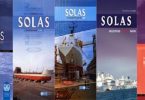THE MAIN OBJECTIVES OF THESE GUIDELINES ARE:
- To assist ship owners in preparing shipboard oil pollution emergency plans in conformance with the cited regulations; and
- To assist Governments in developing and enacting domestic laws which give force to and implement the cited regulations.
In the interest of uniformity, Governments are requested to refer to these Guidelines when preparing appropriate national regulations.”
Paragraph 1.4, the last sentence is amended to read:
“Effective planning ensures that the necessary actions are taken in a structured, logical, safe and timely manner.”
Paragraph 1.4.4, the first sentence is amended to read:
“The Plan envisioned by regulation 26 of Annex I of the Convention is intended to be a simple document.”
Paragraph 1.4.4, the last sentence is amended to read:
“If such information is relevant, it should be kept in annexes where it will not dilute the ability of ship’s personnel to locate operative parts of the Plan.”
Paragraph 1.4.6, the second and the third sentences are amended to read:
“It must therefore be available in a working language or languages understood by the master and officers. A change in the master and officers which brings about an attendant change in their working language or languages understood would require the issuance of the Plan in the new languages. “
The following new paragraph 1.4.7 should be added after paragraph 1.4.6:
“1.4. 7 The Plan should clearly underline the following :
“Without interfering with shipowners’ liability, some coastal States consider that it is their responsibility to define techniques and means to be taken against an oil pollution incident and approve such operations which might cause further pollution, i.e., lightening. States are in general entitled to do so under the International Convention relating to Intervention on the High Seas in Cases of Oil Pollution Casualties, 1969 (Intervention Convention) .”
Paragraphs 2.3.1.1.1 is amended to read:
.1 a discharge of oil above the permitted level for whatever reason including those for the purpose of securing the safety of the ship or saving life at sea; or
Paragraph 2.4.3.1 is amended to read:
“2.4.3.1 In order to expedite response and minimize damage from a pollution incident, it is essential that appropriate coastal States should be notified without delay. This process is begun with the initial report required by article 8 and Protocol I of the Convention. Guidelines for making this report are provided in section 2.3.
Paragraph 2.5.2.1, the first sentence is amended to read:
“The Plan should outline the procedures for safe removal of oil spilled and contained on deck.”
Paragraph 2.5.2.2 is amended to read:
“.2 Spills resulting from casualties: Casualties should be treated in the Plan as a separate section. The Plan should include various checklists or other means which will ensure that the master considers all appropriate factors when addressing the specific casualty. These checklists must be tailored to the specific ship and to the specific product or product types. In addition to the checklists, specific personnel assignments for anticipated tasks must be identified. Reference to existing fire control plans and muster lists is sufficient to identify personnel responsibilities. The following are examples of casualties which should be considered:
2.1 Grounding;
2.2 Fire/explosion;
2.3 Collision (with fixed or moving object);
2.4 Hull failure;
2.5 Excessive list;
2.6 Containment system failure;
2.7 Submerged/foundered;
2.8 Wrecked/stranded;
2.9 Hazardous vapour release.”



